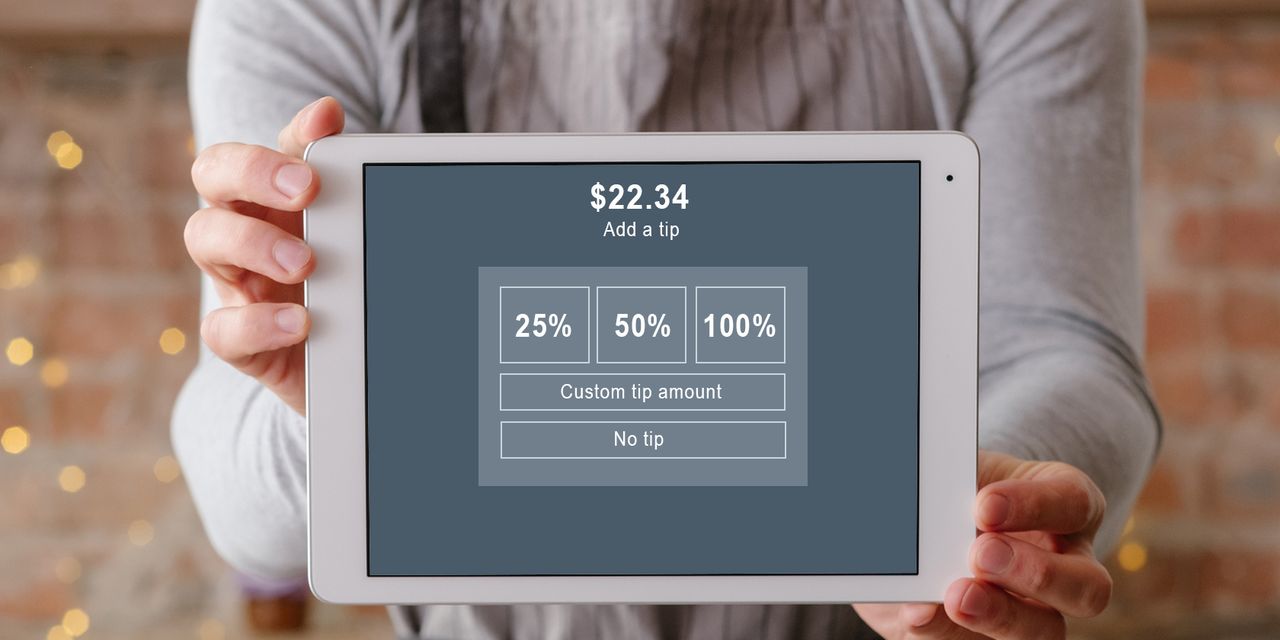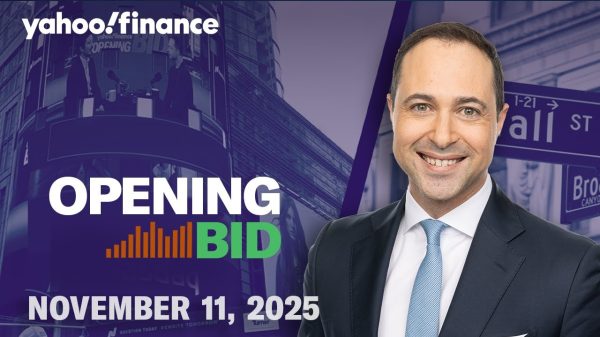If you think tipping is weird now — and you feel like you’re being asked to add a gratuity to every single purchase or service — then you’re not alone.
Tipping fatigue is real, with two in three Americans (66%) surveyed in a recent Bankrate report admitting that they’re feeling less gracious about gratuities these days. And almost one-third (30%) of those surveyed say that tipping has “gotten out of control” — particularly with the rise of touchscreen-tipping and payment apps suggesting preset gratuity amounts of 30% or more. Another one in three survey respondents say they get “annoyed” when encountering these tip screens at coffee shops, retailers and self-checkout kiosks.
Even MarketWatch’s financial etiquette expert, The Moneyist, has been inundated with readers complaining that tipping is “not a gratuity anymore, it’s become another tax.” One reader wrote about being asked to tip 15% when making a charitable donation, for example.
The Moneyist: ‘Tipping culture is out of control’: I was asked to tip 15% when I made a donation to charity. When will this madness end?
“There is pressure with tipping,” agrees modern manners and etiquette expert Diane Gottsman. “We don’t want to look cheap. We want to be fair, but we don’t want to be taken advantage of.”
To be sure, tipping has always been a source of anxiety (or annoyance) for people. Daniel Post Senning, the great-great grandson of etiquette icon Emily Post, tells MarketWatch that his family has been offering gratuity guidance for five generations now. But Senning notes that three things have shaken up tipping culture over the past few years, which has fueled much of the recent frustration, including:
- Some people tipped more during the pandemic as a way to support local businesses and essential workers. But now that things have reopened, there’s confusion over whether it’s OK to tip at lower, pre-COVID rates again.
- The technology shift has created more online services, such as food-delivery and ride-sharing apps. And folks are paying for these things with online or digital payment methods, which often present a tipping screen with suggested gratuity amounts that may be higher than what someone planned to give — if they were going to tip at all.
- Finally, inflation has driven up the cost of many goods and services over the past couple of years, which has also raised gratuities. So if you’re tipping 20% on a tab, for example, it’s 20% on a higher amount than it may have been a year ago, which means the tip is also going to be higher.
“I think, with those three things coming together … there is genuine frustration around tipping, and understandable confusion, or even a feeling of pressure that people resist against,” says Senning.
But one thing hasn’t changed: In many cases, tipping is still optional. (There are a few exceptions, which we’ll get to below.) For example, Gottsman was recently buying a souvenir T-shirt at a restaurant, and was prompted to leave a tip. “I thought to myself, ‘Gosh, do I tip on a T-shirt?’” she said. And the answer was: “No!”
The good news is that while we have ever more options and opportunities to tip now, “we also have the option to say ‘no’ when necessary,” Gottsman says. “We just need some knowledge.”
“Tipping touch screens are really just modern-day tip jars. That means you don’t have to feel pressured to give a 20% to 30% tip to the person who simply handed you your coffee. ”
And that includes tipping touch screens, which are really just modern-day tip jars. “The tip jar was always discretionary,” Gottsman says. “So think of the payment app or tip screen as the same thing as dropping change in the tip jar.”
That means you don’t have to feel pressured to give a 20% to 30% tip to the person who simply handed you your coffee, unless you genuinely want to do so (or maybe you’re a regular customer at this cafe.) “They are being paid at least minimum wage,” Gottsman says. So if you want to leave a dollar, leave one. If you don’t want to tip, just look up, smile, and say “thank you” on your way out.
And in fact, there are several services which never get a tip, period:
NO-TIP
The general rule here is that you don’t tip professional or health services, like teachers, lawyers, doctors or nurses. And government workers and U.S. Postal Service employees don’t get tips either. In fact, it’s against the law to give postal employees cash tips or equivalents like checks and gift cards. So, some jobs and services that you do not tip on include:
- Accountants
- Airline pilots
- Cable/IT professionals
- Chiropractors
- Dentists
- Doctors
- Flight attendants
- Government employees
- Lawyers
- Law enforcement/police officers
- Nurses
- Postal workers — including FedEx and UPS delivery workers
- Teachers
- Therapists
Why? Because there are ethical concerns for most of these. “It could come across as a bribe,” Gottsman says.
What’s more, you’re not required to tip a retail cashier — even though it might feel awkward when they turn that tipping screen toward you, and they’re watching you decide whether to tip or not. “If it’s a retail product and they didn’t deliver it to you, someone just handed it over, feel free to hit ‘no tip,’” Gottsman says, adding, “The counter rep is getting paid an hourly wage.”
And you certainly don’t need to tip on a self-checkout kiosk.
So MarketWatch spoke with etiquette experts to come up with a comprehensive 2023 tipping guide that updates the rules on traditional tipping — like restaurant waitstaff and bartenders, barbers and hairdressers, or hotel housekeepers — as well as modern-day digital dilemmas like online delivery a la DoorDash and Grubhub, ride-shares like Uber and Lyft, plus the touch screen tipping that has sprung up seemingly everywhere. And Gottsman helped us separate these services into categories, including: dining services, travel and transportation, plus salons and spas.
Here’s a cheat sheet:
And here’s a more in-depth breakdown:
FOOD AND BEVERAGE SERVICE WORKERS
Sit-Down Restaurant Service: 15% to 20% pretax — and this is not optional, except in the extreme situation where the service was truly terrible. “If you’re not going to tip, it means there was an issue that was big enough that you really want to be talking to a manager or an owner,” Senning says. “You’re essentially saying, ‘I refuse to pay full price for this meal.’”
Restroom Attendant: $1 to $5 per service, such as if they sew a hem or give you an emergency personal item. If they do nothing at all, you may smile and be gracious without a tip.
Valet: $3 to $10 once the car is returned to you (a tip is not part of the valet fee.) “It’s not about paying the valet not to mess with your car,” Senning says. “In fact, you’re supposed to tip after you get the car back for just that reason.”
Buffet Service: 10% pretax
Carry Out/To-Go Order: Tipping is optional, or 10% to 20%, depending on the complexity of the order, or for curbside service.
Food Delivery: 10% to 15% of the bill, or $2 to $5 for pizza delivery, depending on the size of the order and the difficulty of delivery, such as inclement weather.
Drive-Through: You don’t have to tip, Gottsman says, but you can leave a little something if you want to.
Coffee Shop: Tipping is optional for counter workers and cashiers, Gottsman says — but she recommends using the custom tip button to leave $1 or more, or you can opt for the tip jar.
Self-Serve Food/Ice Cream/Yogurt Bar: Tipping is optional — but 5% to 10% if you do decide to leave a little extra.
Food Truck: 15% to 20% — Gottsman says that, “The workers are hot, working hard and making everything while you wait.”
Bartender: Minimum of a dollar per drink ($1 for beer, $2 for each cocktail) if paying by the drink, or 15% to 20% of the total when running a tab.
Tipping Jars: Optional, but it’s nice to drop in extra change or a dollar or so, depending on the quality of the service provided, or if you’re a regular customer.
Grocery Store: You don’t have to tip, and Gottsman notes many stores offering curbside pick-up don’t allow tips.
TRAVEL AND TRANSPORTATION
Airport Curbside Concierge (checks you in and takes your bag at the airport curb): Each airline has its own suggestions, which will be displayed at the counter. If not, $3 for the first bag, and $2 for each additional bag.
Airport Wheelchair Service/Special Assistance: $3 to $5
Doorman: A friendly greeting is always appropriate, or $2 to $4 for services like hailing a cab, helping with luggage, offering an umbrella or other polite services.
Bellhop: $2 to $5 for one bag, $1 to $2 for each additional bag. If requesting an extra robe, luggage rack, ice, etc., add an additional $2 to $3.
Hotel Housekeeper: $2 to $5 each day — and do not wait until the end of your stay to tip all at once, since different housekeepers could be tending the room on different days. And leave the tip with a note that says, “For Housekeeping. Thank you” so it’s clear this is a tip.
Concierge: There’s no obligation to tip if they’re just answering simple questions. But for securing reservations, theater tickets or something similar, give $10 and up for hard-to-get seats or tickets.
Courtesy Shuttle Driver: $2 to $5
Rental Car Shuttle Driver: $1 to $2 per bag
Taxi/Uber/Lyft Driver: 15% to 20% of the fare
Roadside Assistance/Towing Services: $10 to $20
BARBER SHOP/SALON/SPA WORKERS
Barber/Hair Salon: 15% to 20%, and ask for it to be split among those who served you – like the person who washed your hair, the person who cut your hair, etc.
Manicurist: 15% to 20%
Massage: 15% to 20% of the full cost of the service. Gottsman says that if you use a coupon, you should tip on the full price, not the discounted fee.
Facial, waxing, eyebrow service or lash extensions: 15% to 20% of the full cost of the service — again, not the discounted fee if you have a coupon.
Tattoo Artist: 15% to 20%
AND DON’T FORGET…
Pet Groomer: 15% to 20%
Movers: $20 to $30 per person for a relatively short, uncomplicated move (like from one small apartment to another), and it’s also nice to offer up some water or a sports drink. For larger or more complicated moves, like a full-day move between big houses with tons of stairs, Gottsman suggests maybe $50 to $100 per person, although “$100 per mover is generous.”
A final word:
Tipping is supposed to make both the giver and the recipient feel good. “The root of the word ‘gratuity’ is the same as the root of the word ‘gratitude.’ Ultimately, this an expression of thanks, of generosity, of appreciation,” says Senning. “Part of what is meant to feel so good about a tip is that it’s optional; you choose to give something extra, and when you choose to exercise that, it’s a special thing.”
And let’s say that you have under (or over) tipped in the past — don’t sweat it. Now you’re armed with the information to better decide how much you want to tip moving forward.
“There’s no tipping police or authorities, no one who will come after you,’ Senning adds. “Tipping is really meant to come from a spirit of generosity and a moment of appreciation.”
More about tipping on MarketWatch:
The Moneyist: I’m sick and tired of tipping 20% every time I eat out. Is it ever OK to tip less? Or am I a cheapskate?
The Moneyist: ‘All of these tips add up’: If a restaurant adds a 20% tip, am I obliged to pay? Should tipping not be optional?
The Moneyist: ‘Enough touch screen tipping already! I’m over it’: Two years into the COVID-19 pandemic, do I have to tip for coffee, ice cream and takeout? Am I being cheap?
Read the full article here











